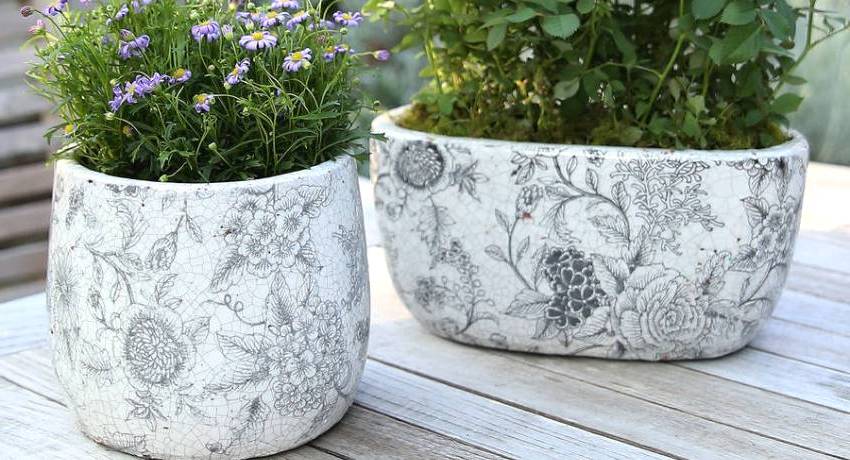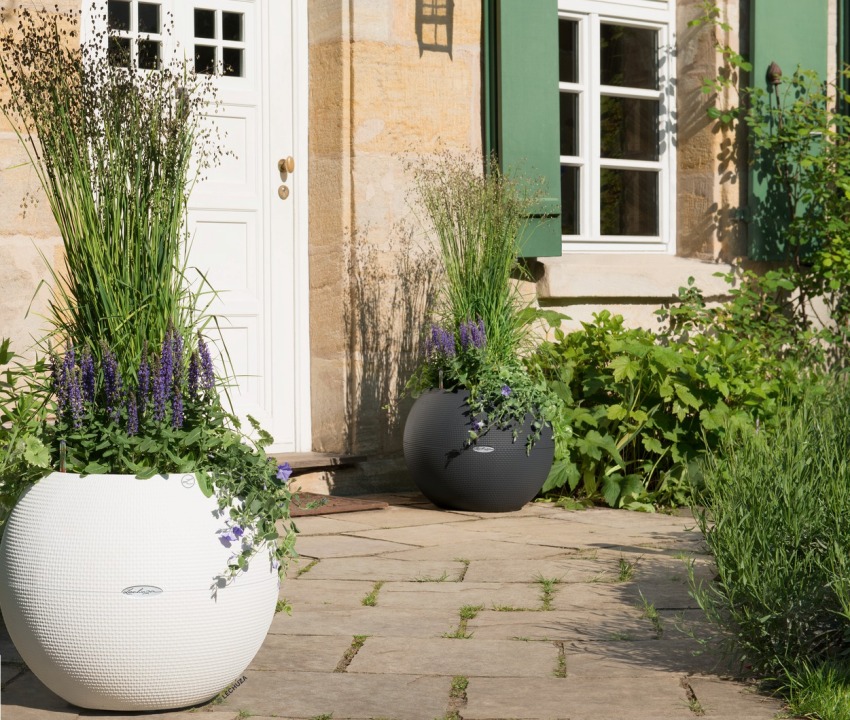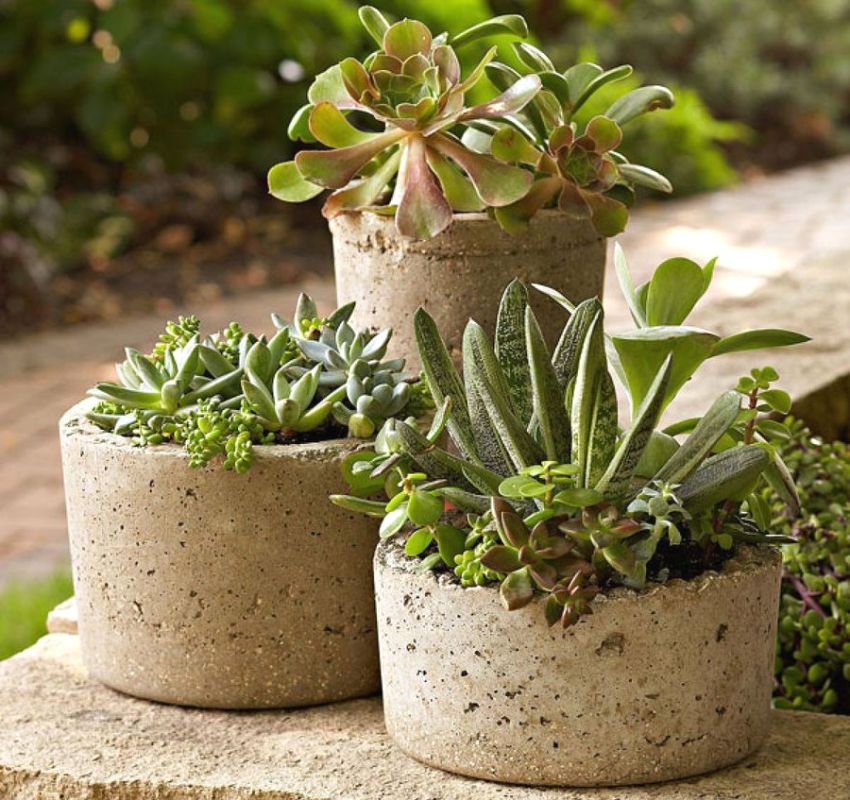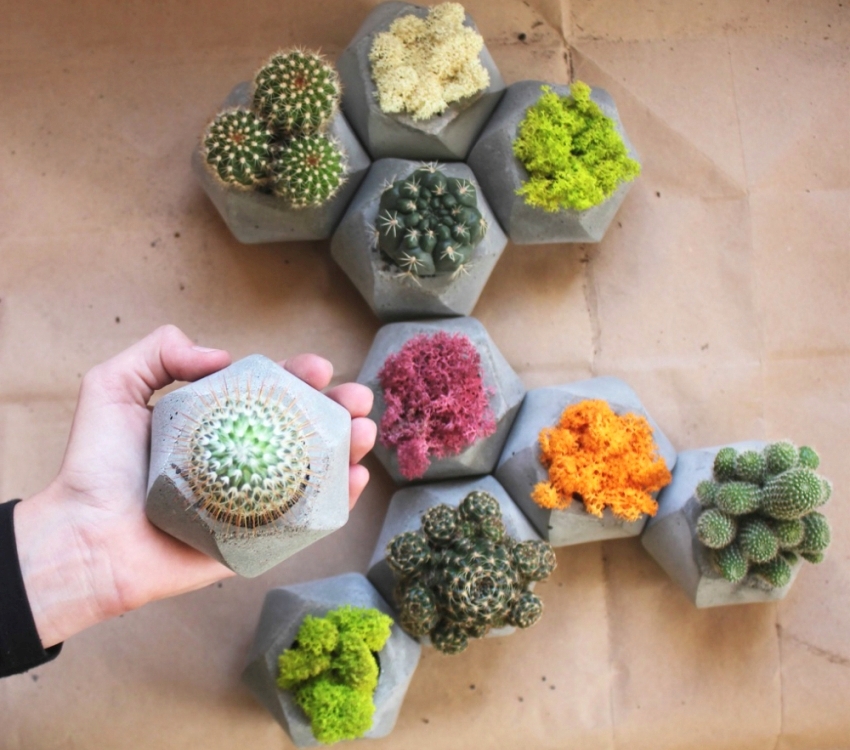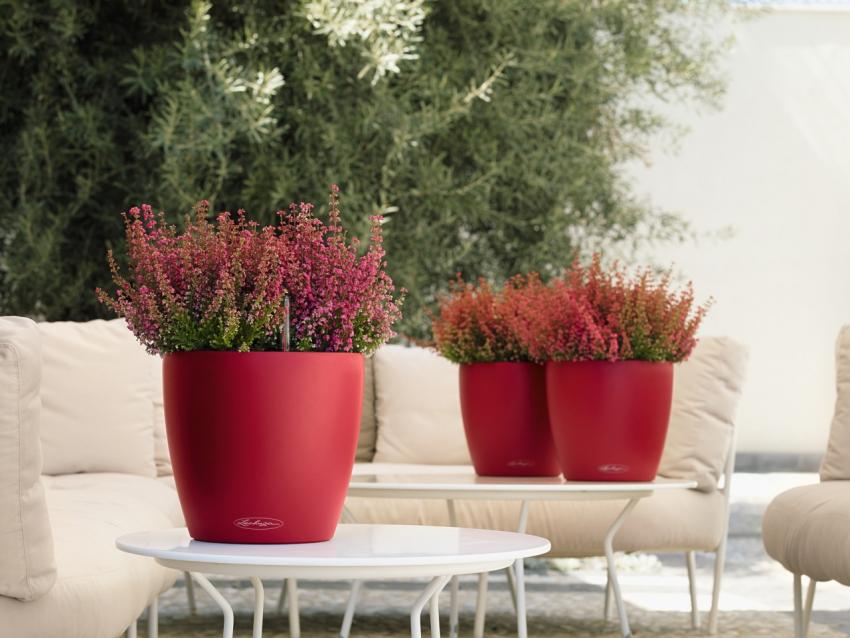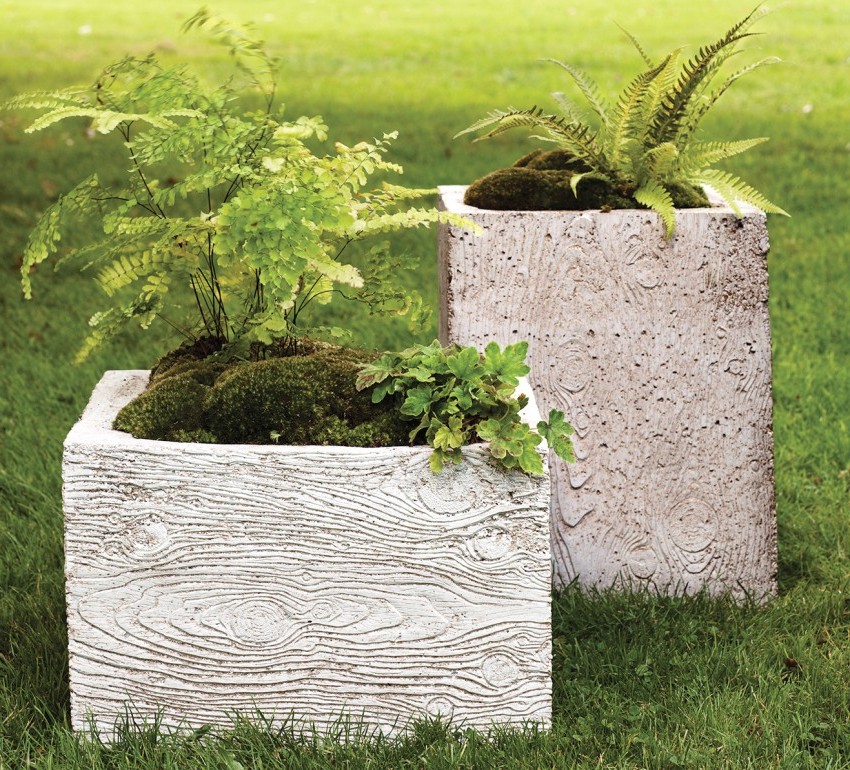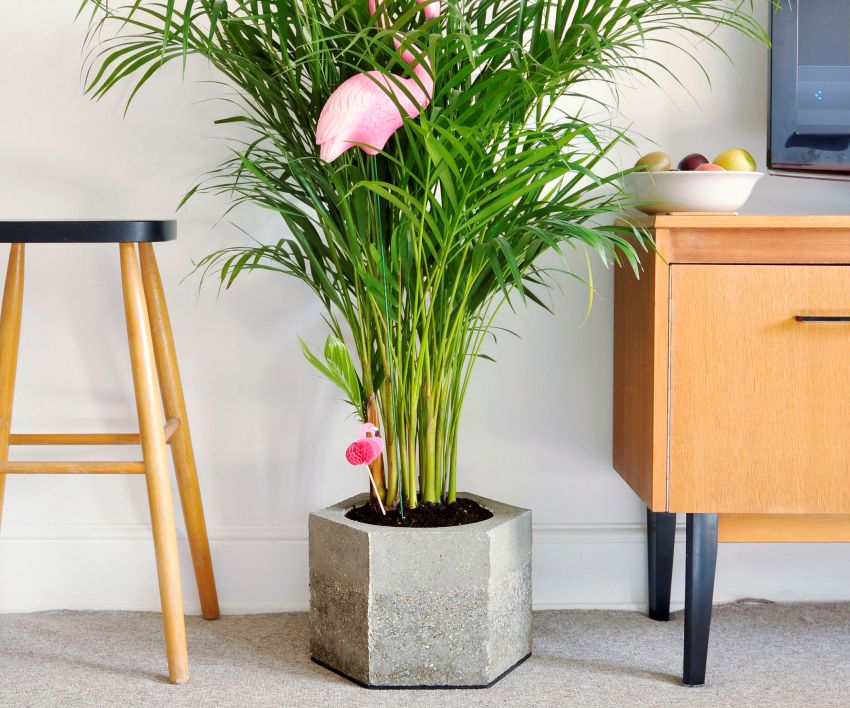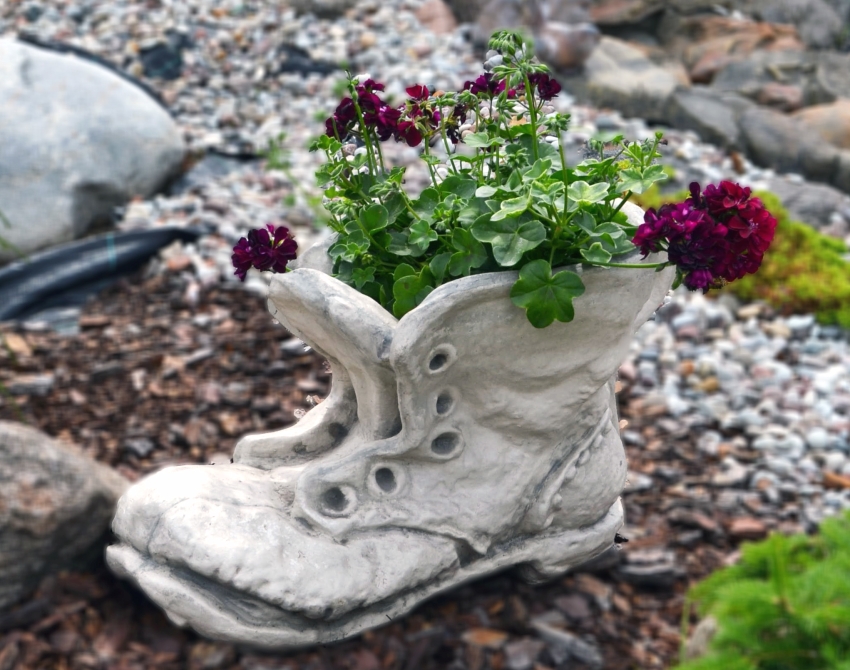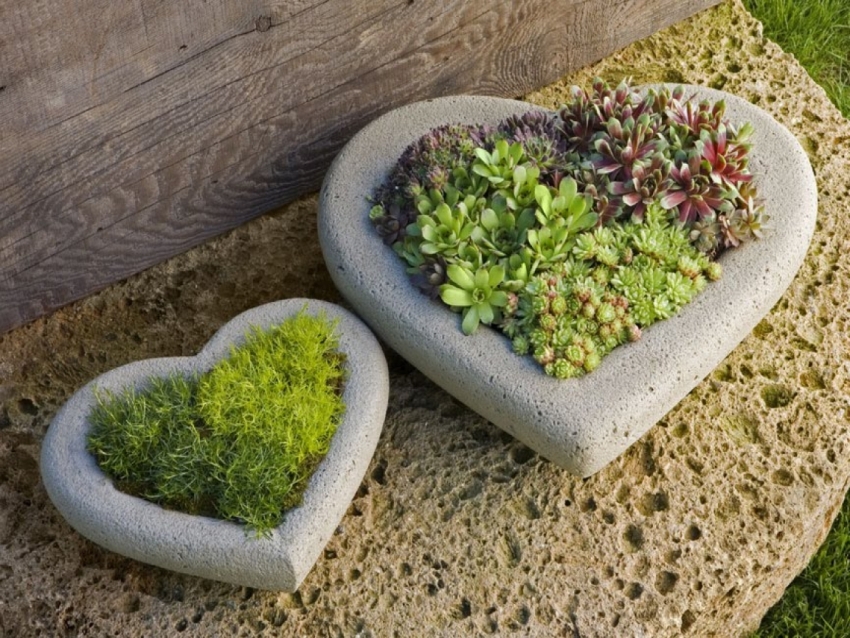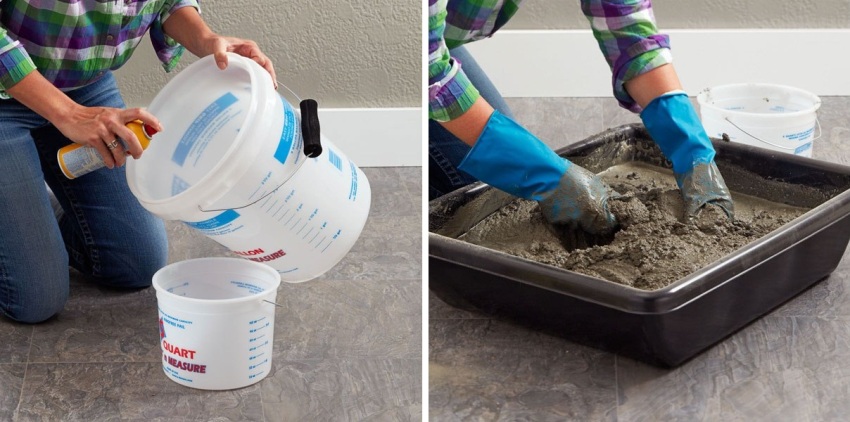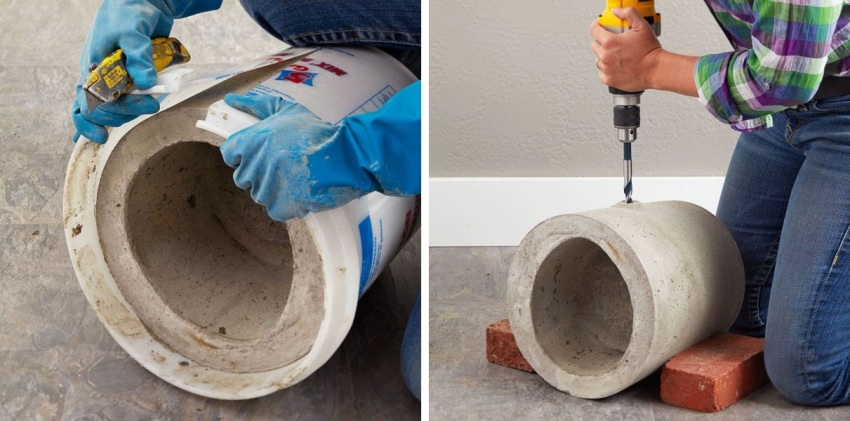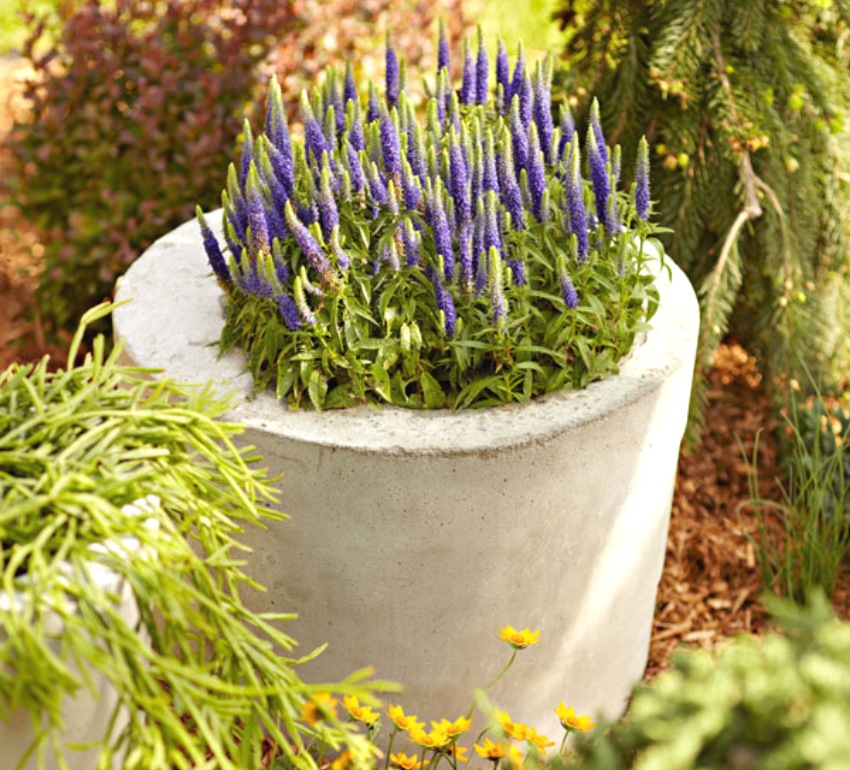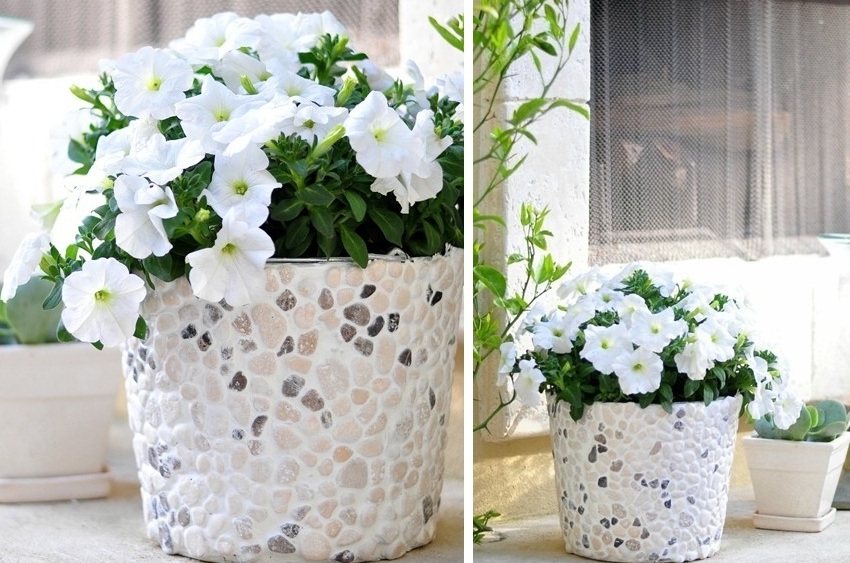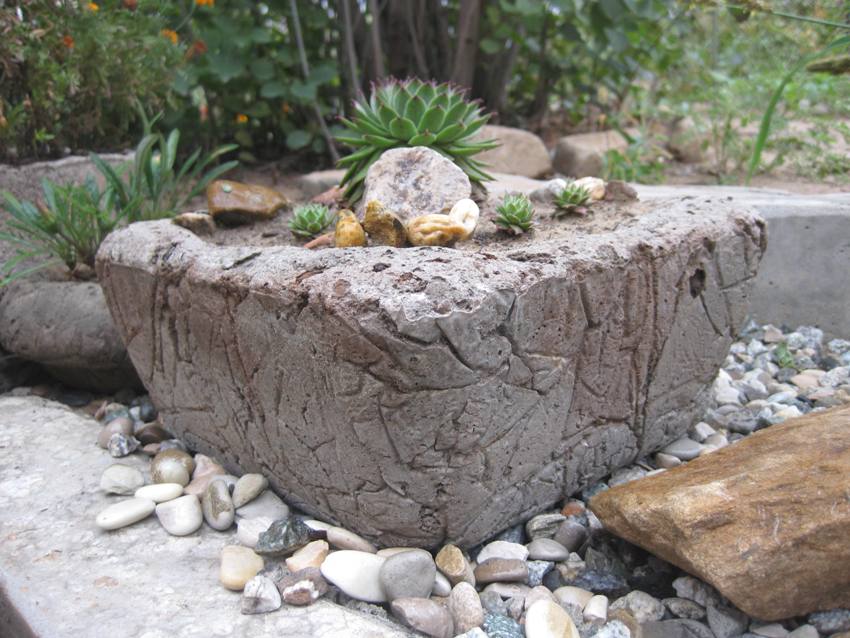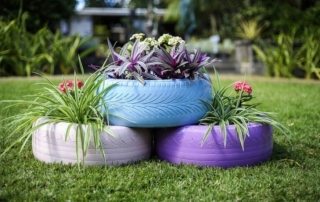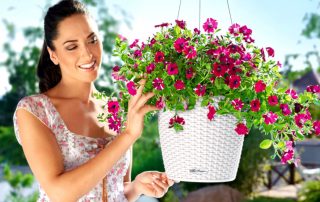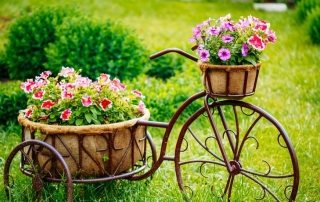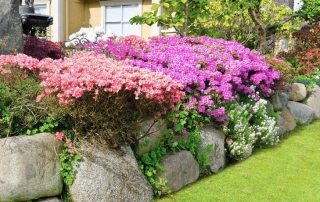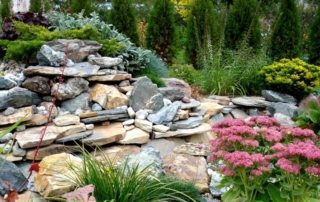We are all pleased with a beautiful fragrant garden plot or just a flower bed near the house. Perhaps it will seem to someone that it is very difficult and troublesome to set up a flower garden, and most importantly, costly. In fact, this is easy to arrange using concrete outdoor flowerpots, which can also be made with your own hands. The article will consider examples of how to make do-it-yourself flowerpots for the garden, and give recommendations on how to make concrete flowerpots yourself.
Types of flowerpots for the garden
The whole variety of flower pots can be conditionally divided according to their functional purpose, i.e. according to the purpose for which they will be used:
- street;
- decorative;
- room.
The main materials that are most often used to make flower pots:
- clay;
- plastic;
- metal;
- natural stone;
- concrete;
- all types of wood: natural wood, stumps, boards, plywood, etc.
Each of these materials has a number of advantages and disadvantages. Which one to choose is up to you. However, outdoor concrete flowerpots are a common type of product. This is due to the fact that they have a number of advantages, which will be discussed below.
In any case, in order for the flowerpot to please the eye for many years and not bring additional trouble, before purchasing it is necessary to take into account some important points: the weight of the product, its dimensions, resistance to external influences and moisture, the manufacturer, the material for production, and of course the price.
Concrete outdoor flowerpots
An outdoor concrete flowerpot is a universal design, intended both for use in urban conditions and for a wide variety of flower beds in personal plots. When operating in urban conditions, the main tasks that they perform are the beautification of areas adjacent to roads, greening of sidewalks, use as a fencing element.
Many downtown institutions, offices and shops use concrete pots to decorate and demarcate their territory. In this case, an outdoor concrete flowerpot is a great alternative to flower beds. This is the easiest way to make your office building, parking lot or store unique. The territory decorated with such structures will undoubtedly not be left without attention and will help to attract customers.
Such containers can have a wide variety of sizes, intricate shapes, and be painted in various exotic colors. Their great weight when used as an urban decoration can be attributed to the undoubted advantages.
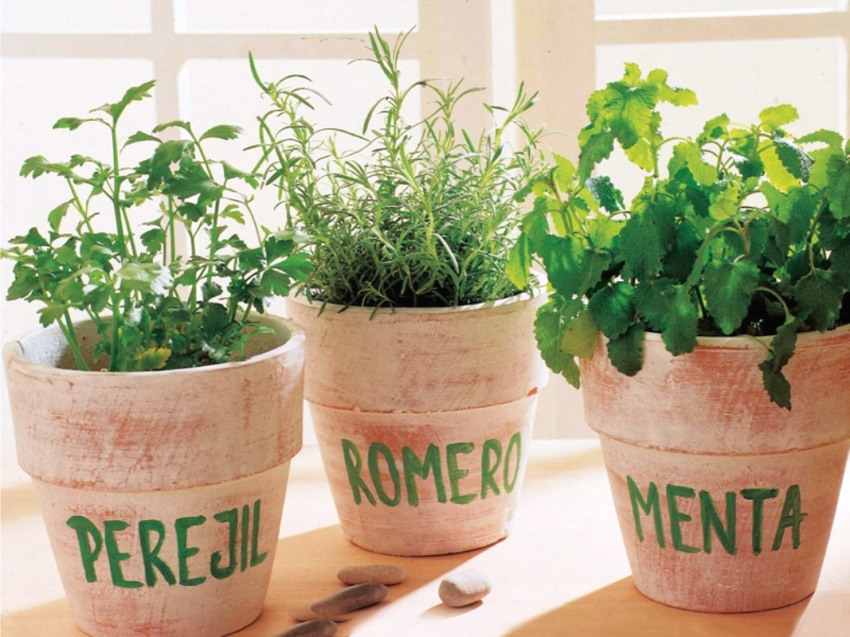
Decorative planter for flowersmade of concrete
If you have already realized that you cannot do without them, the easiest way is to buy outdoor flowerpots in a specialized store. Here buyers will be offered a wide variety of shapes, sizes and colors from different suppliers and manufacturers. The challenge is to choose from this abundance what is right for you.
Note! Considering that large concrete flowerpots can weigh up to 300-400 kg, you should immediately think about where you will place them and take care of organizing their unloading.
In terms of use as a building envelope and as a durable element of the street landscape, a concrete tank is beyond competition, therefore it is used most often.
Concrete or plastic flowerpot: which is better
Along with concrete structures, plastic ones have found their widespread use. Considering the cheapness of the material and ease of manufacture, it will not be difficult to buy outdoor plastic flowerpots. Basically, plastic products are used as indoor flowerpots. The names, photos and prices of such containers can be found on the manufacturers' websites.
Despite the fact that the low price has led to the widespread use of both small and large plastic flowerpots, which can be bought for use in the garden, in the country, in the office and at home, concrete containers are still much more reliable and solid. The indisputable advantage of plastic products is their mobility. Due to their low weight, they can be moved relatively freely around the site. While concrete flowerpots can be used as enclosing structures and at the same time play the role of small architectural forms.
Outdoor plastic flowerpots keep moisture in the soil well, preventing it from drying out. It is a good choice for planting perennial plants. However, such pots can be destroyed by mechanical and chemical action, lose their appearance over time and fade in the sun. Such disadvantages are especially characteristic of plastic vases. Concrete tanks are practically devoid of the above disadvantages.
The use of plastic flowerpots, given their disadvantages, is limited. However, if you need a mobile, inexpensive and practical design element, then in many cases it is justified. Moreover, it is cheaper to buy plastic flowerpots than cement counterparts. Concrete containers, in turn, will help you create a unique design for a garden plot, are suitable for planting almost any plant and will last a very long time. It should be noted that in many cases concrete products look more solid, richer and much better emphasize the originality of the flower arrangement.
Prices for ready-made concrete flowerpots
The table below shows the current prices at which you can buy outdoor flowerpots:
| Flowerpot shape | Size (LxWxH), mm | Weight, kg | Price, rub / piece | ||
| Unpainted (gray concrete) | Colored | Colored | |||
| Rectangular | 620x430x430 | 125 | 3100 | 3800 | 4100 |
| Hexagonal | 980x850x450 | 238 | 4000 | 4700 | 5000 |
| Square | 560x560x430 | 147 | 3500 | 4200 | 4500 |
| Round | ᴓ860x350 | 165 | 5500 | 6200 | 6500 |
| Round in the form of a cup on a leg | ᴓ420х510 | 37 | 3550 | 4250 | 4550 |
| L-shaped | 440x440x880 | 70 | 5800 | 6500 | 6800 |
| Star shaped | ᴓ1030x270 | 73 | 4990 | 5690 | 5990 |
| Crescent | ᴓ610х250 | 47 | 1800 | 2500 | 2800 |
| In the form of a fountain (multi-tiered) | — | 430,5 | 24890 | — | — |
DIY outdoor flowerpots
Decorating a garden, vegetable garden or summer cottage is a very pleasant and exciting business, but it requires certain financial investments. To reduce the cost of decorating the site, you can make flower pots yourself. Next, we will talk about how to make outdoor concrete flowerpots for flowers with your own hands.Let's consider the process of making containers from cement mortar in detail. This is the most affordable, inexpensive, environmentally friendly and easy-to-process material from which masterpieces of landscape design are obtained.
DIY concrete outdoor flowerpots
Both very large flowerpots and small flower pots are made of cement. What is good about concrete is its plasticity, which allows it to take almost any shape you come up with. The mixture can be made at home from cement mortar with the addition of other components. To make such structures, you can use the most ordinary concrete, which is prepared by mixing a solution of cement and sand in a ratio of 1: 3 or 1: 4.
Useful advice! To obtain a strong and durable product, it is recommended to use Portland cement of a grade not lower than M400 and sifted river sand.
The flowerpot will turn out to be gray, will not be conspicuous and will not draw attention to itself.
Concrete flowerpots made with decorative additives look very interesting and unique. Such a solution can be bought ready-made, it is called: art-concrete, polymer-concrete, acrylic-concrete, artistic or architectural. In addition to standard components (cement and sand), it contains fine fractions of natural minerals, polymer additives and dyes. There are a great variety of such compositions, the choice is, as always, yours. Products made from this material are smoother, more colored, with inclusions of fine fractions of stones and minerals.
You can prepare the original composition with your own hands. For example, make a mortar from white cement, one part of perlite (agroperlite) and two parts of peat. The three-component mixture is diluted with water until a thick mass and homogeneous consistency is obtained.
Do-it-yourself forms for concrete flowerpots
If you need pots of significant size or some specific configuration, then the easiest way is to buy molds for making flowerpots from concrete in a specialized store. If this option is not for you, almost anything can be used as a pot shape.
Plastic, wooden, glass, metal containers and even cardboard boxes are suitable for the manufacture of a flowerpot. The main thing is that they keep their original shape and do not get soaked for about 4-5 hours. This is the time it takes for the concrete to set and hold its shape. If you need a small flowerpot, packing cardboard reinforced with slats or tape will do.
If there is an old bucket or saucepan in the country, do not rush to throw them away. They will make an excellent shape for your future flowerpot. The easiest and most convenient way to work with plastic, it is quite flexible and does not get wet, it is very easy to remove finished products from it. Glass containers are good for the form, but they have one drawback. If the product cannot be removed from the glass mold, the mold must be broken.
When choosing a form, you need to understand that you need at least two of them. One creates the outer surface, and the other, smaller, is inserted inward and forms a space where soil will be poured and plants will be planted. The distance between them is the thickness of the walls of the flowerpot, it depends on the size and shape of the product, but in any case, it is recommended to make it at least 3 cm.The inner surface of the bowl can be decorated with plastic glasses, cups, old flower pots, bowls.
In the absence of all this, you can make a form from plywood, cardboard and boards in the form of formwork. It is desirable that the inner surface has a more or less regular shape.
Useful advice! If you plan to make a large concrete flowerpot, then it must be reinforced with a wire frame or fiberglass added to the solution for strength.
Making concrete flowerpots for flowers with your own hands: photo and description
To make a large pot of concrete, you need to buy a mold for it from a durable material with the required dimensions of diameter and height. The composition of the solution can be either the simplest or with a variety of additives. The composition of concrete was discussed in the previous sections. Such a flowerpot can be made multi-colored. To do this, you need to divide the solution into parts. Various dyes are added to the mixture to add color. Then it is placed on the inner surface one by one, which gives the finished product the desired color.
Related article:
Do-it-yourself flower beds and flower beds from scrap materials: photos and a guide to creating
Classification of products for planting plants, good examples of flower beds. Description of interesting design ideas.
It all depends on what kind of end result you want to get. A one and a half liter ladle is taken as a measuring vessel. In addition, you will need a container of water, a spatula or a trowel. When working with cement, be sure to use gloves - the solution quickly corrodes your hands. To work with cement, the ambient temperature must be above 5 ° C. Ideal conditions are 20 ° C and high humidity.
Note! Since the product can be too heavy, it is best to make the flowerpot in a permanent place.
As an example, let's take a large plastic pot that will serve as a shape and cover the inside with plastic. The laid film must be carefully straightened so that the surface is leveled and ugly folds and irregularities are not printed on the future product. Another option is to treat the molds with a lubricant. It is acceptable if the flowerpot has a complex configuration. This will ensure easy separation of the finished product from the mold. As a lubricant, you can use:
- all types of engine oil, incl. spent;
- all kinds of nonsticks and cooking sprays;
- special sprays for concrete products. You can buy them at a hardware store;
- any kind of universal grease type WD-40.
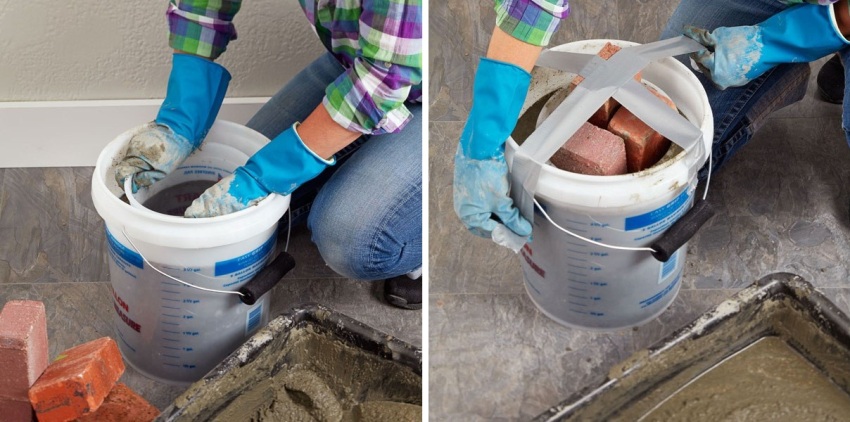
Steps 3 and 4: installing containers one into one and filling the empty space (future walls) with mortar
With a thoroughly mixed mixture, carefully fill the form. First, spread the solution to the bottom. Then gradually apply a layer to the side surfaces. The mixture should not be too liquid, as it will drain from the walls and make the task very difficult. We control the thickness of the layer, which for a large flowerpot should be about 4-5 cm. A rod or thin pegs are excellent for control.
In order for the solution to hold during application, and to increase the strength of a large product as a whole, we recommend inserting a wire frame or other reinforcing structure. For the same purpose, you can add fiberglass to the mixture during preparation.
When making a large flowerpot, it is difficult to immediately mix the required amount of solution with your own hands, so you have to divide the process into several stages. It may take about four or five batches. When making flowerpots for the garden with your own hands, do not forget about such an important detail as a hole for drainage. It is not difficult to make it; it is enough to place a cork or a piece of tube wrapped in cellophane at the bottom.
It should be noted that if the flowerpot is large enough, then you can do without the inner shape. However, if the container is made with it, then both are treated with a lubricating composition: a large one - inside, a small one - outside.
Next, we install the second form on the solution.To prevent dangling, you can fill it with stones, sand or rubble. Now you need to fill the gaps between the walls with the mixture. In order for the concrete to settle down, you need to knock on the surface with a hammer, if the material allows, and pierce the solution to the bottom with a stick or rod. It is better to repeat this procedure several times. Then we take a rounded smooth object and carefully align the edges of the walls, we try to make the side as even as possible.
Now you can cover the filled mold with a plastic bag and leave to harden for at least a day. After that, we lower the flowerpot into a container of water and wait a week. Or you can cover the structure with a film and sprinkle with water 3-4 times a day. After 10-14 days, you can plant the plants in the container.
DIY flowerpot decoration
Decorated flower pots will help to liven up the interior and create the right atmosphere, whether it be a garden, a private house or even an apartment. If you wish, you can create such a decoration yourself. For decoration, an ordinary concrete flowerpot of square, rectangular or round shape, which was purchased in a store or made independently, is suitable.
The easiest way to freshen up a container is to decorate it with paint. Before that, you need to treat the pot with a deep-penetrating primer. For coloring the product, paints are used that are resistant to moisture, for example, acrylic. You can change the color of the flowerpot even at the filling stage if you add the desired dye to the cement mixture.
Useful advice! You should not get carried away with bright decor and paint the flowerpots in colors that will strongly highlight the structure on the site, thereby distracting the eye from the flower arrangement planted in a pot. For landscape design, flowerpots of light and warm shades, for example, beige, are best suited.
Another type of flowerpot decoration is a bas-relief. For a simple pattern, you can use the leaves of burdock or another large-leaved plant. They are fixed on the inside of the mold, after which it is poured with cement mortar. Once dry, the leaves are easily removed with water and leave beautiful prints. Then they need to be highlighted with light toning and our bas-relief is ready.
After a summer vacation at the sea, you can accumulate many sea pebbles, shells or pebbles. Such natural materials are the best fit to make the flower bed unique. To attach the shells, we use building glue, which dries quickly. To get started, you need to rinse and clean the marine elements. Then we apply glue to the outside of the pot and the base of the shell. We fix it in one position until the glue is completely dry. When our flowerpot is completely dry, we open it with varnish.
Summing up, we can say that concrete flower beds are a modern and practical solution for arranging landscape design. Their use will help to tastefully decorate the site or create hedges that will decorate the territory for more than a dozen years.
